Visiting the Bowtie in the spring, I stood on the expanse of asphalt that dominates the public park and greenway and looked out across the nearby Los Angeles River. The cracked surface—once a roadway—stretched ahead of me, following the curves of the river. A former rail yard and switching station, the Bowtie was purchased by the California State Parks Department in 2003. Eighteen acres in total, the public park abuts the section of the L.A. River known as the Glendale Narrows, a seven-and-a-half-mile stretch of the river that is “soft bottom,” meaning water fl ows atop a natural dirt bed rather than concrete. The day I visited it was hot, and the palm trees offered little respite from the sun. Still, the river was swollen with water and clogged with vegetation after the winter rains of January and February 2017. It was here, in summer 2014, that Los Angeles-based performance artist Rafa Esparza and choreographer Rebeca Hernandez performed their collaborative piece, building: a simulacrum of power. The piece was presented at the height of California’s drought, when the Bowtie was a dusty stretch of asphalt and quickly browning plants.
Building merged Esparza’s durational performance practice with Hernandez’s training as a contemporary dancer and choreographer. The work was performed atop an expanse of adobe pavers—handmade by Esparza and his friends and family in the months leading up to the performance—which blanketed Michael Parker’s sculptural work, The Unfinished (2014). Parker’s earthwork was created by excavating several feet down through the road’s surface, leaving behind an obelisk-shaped outline. The performance began with Hernandez and three additional dancers—Victoria Wolfe, Olivia Orozco, and Devon Stern—performing a set piece of choreography that was largely contained within the excavated trench around The Unfinished. Their movements, slow and sustained, seemed an attempt to enshroud themselves in a fine layer of dirt and dust. Dressed in jeans, tennis shoes, and plaid shirts, the dancers’ costumes offered protection from the hard cracked earth and were also meant to reference the informal uniform of many day laborers in Los Angeles and across the southwestern United States. Hernandez’s half of building proposed, if not an equivalence, a relationship between the dancers’ movements and the low-wage and often racially delimited work of day laborers.
The second half of building was a solo durational performance by Esparza. Throughout Hernandez’s piece, he stood at the tip of Parker’s obelisk holding a one-foot diameter mirror, refracting the sun’s setting rays onto the adobe and his collaborators’ bodies. Esparza, half naked, wore a skirt made of fabric remnants embroidered with Aztec motifs. In his hair was a bundle of long feathers, and chachayotes, or rattles, around his ankles sounded with each of his steps. Esparza began with a modified Danza Azteca water dance that carried him around the crowd of spectators. Finishing his circuit, he stepped back onto the performance space and began an excruciating crawl on his stomach down the length of the adobe-covered obelisk, which brought to mind Pope L.’s performance Tompkins Square Crawl (1991). Reaching the end of the playing space, he performed a series of concluding ritual gestures, culminating in the burning of a sage plant.
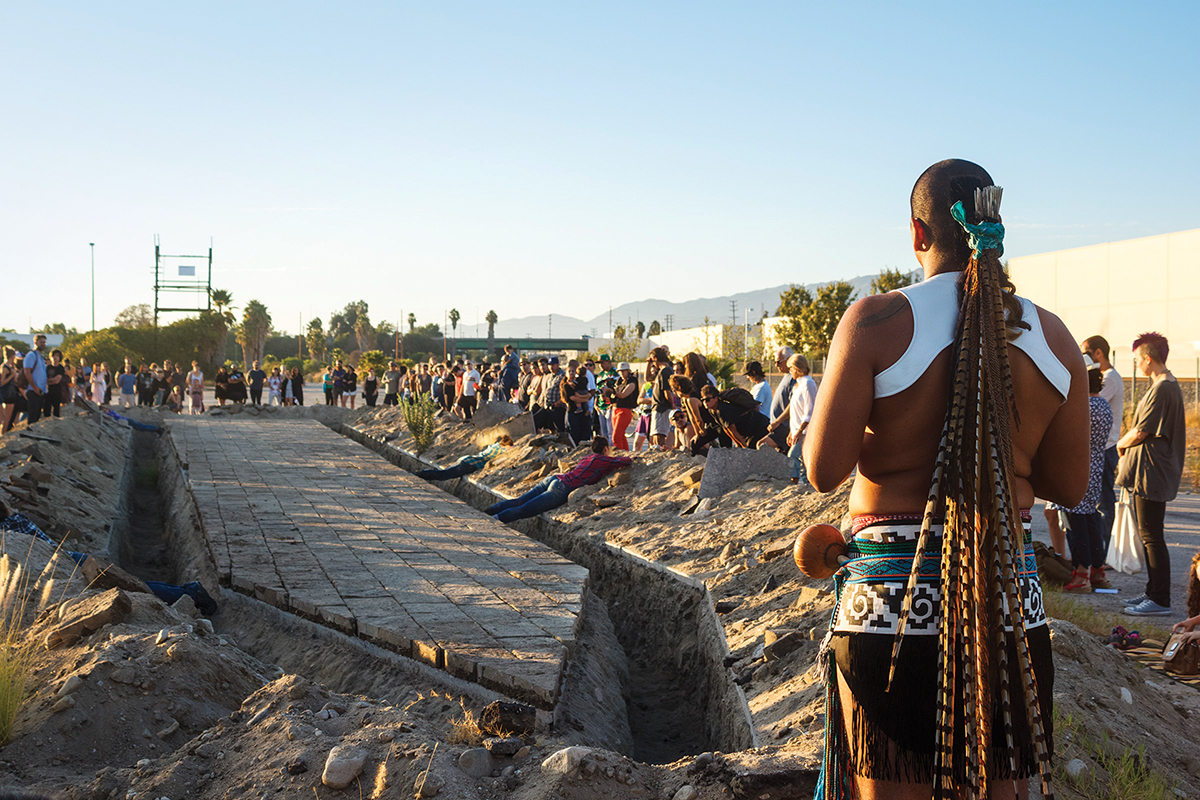
Rafa Esparza and Rebeca Hernandez, building: a simulacrum of power, 2014. Rafa Esparza performs on the site of Michael Parker’s The Unfinished (2014) at the Bowtie Project, Los Angeles, August 24, 2014. Courtesy of Alexis Chanes. Photo: Alexis Chanes.
This is an essay on water, which is to say it is an essay about watersheds, municipal management, urban development, and environmental restoration efforts. Water, or its absence, has long played a defining role in Los Angeles’s aesthetic imaginaries and its urban planning. Over the past decade, municipal leaders and real estate developers have worked in concert, reimagining the city’s relationship to water, in particular the Los Angeles River, which since the 1930s has been almost entirely encased in concrete, to control seasonal flooding. Radically transformed from any sort of “natural” state, the river is also polluted.1 Not until 2010 was it declared fully and entirely protected under the 1972 Clean Water Act. Following this ruling by the Environmental Protection Agency, the city of Los Angeles and the US Army Corps of Engineers, as well as a host of private real estate developers, have begun to reimagine the river, aiming to position Los Angeles as a leader in urban environmental restoration.
Such efforts have included public art commissions, biennials, and programming in waterfront spaces. From September 2014 through September 2015, Project 51, a collective of artists, designers, urban planners, writers, and educators, organized a series of community events and performances on or near the L.A. River, titled Play the LA River. In summer 2016, Los Angeles launched its inaugural public art biennial, Current: LA; the theme of the biennial was water. Since 2015, Clockshop, an artist-run organization that commissions artworks, has managed the Bowtie, which now contains a number of semi-permanent sculptural installations, including Parker’s The Unfinished. The Glendale Narrows, in particular—ideal for environmental restoration—has garnered much of the city’s attention. Indeed, on my recent visit to the Bowtie, the river’s eyots were lush with vegetation, and gulls, ospreys, and swifts circled above the river. But the Bowtie still bears the infrastructural traces of its industrial past. The cracked asphalt road is chief among these traces, but, also, on the other side of the road is a rusted chain-link fence, abandoned railroad lines, and further, the graffiti covered walls of a block of bleached-out warehouses. Dotting the roadway are some half-dozen art installations, though, curated by Clockshop, which have begun to transform the largely industrial-looking space into something resembling an art park.
An important element of projects like Current: LA or Play the LA River is a focus on environmental restoration: on re-greening post-industrial urban spaces through art. But urban environmental revitalization can occlude the interrelated concerns of racial and ethnic justice and thus function as a neocolonial project.2 By analyzing building, which was curated by Clockshop, this essay expands upon an emerging body of post and neo-colonial scholarship that imagines anew the relationships between water, power, and dispossession.3 Building drew upon Azteca iconography and a gestural vocabulary that evoked pre-Columbian ritual practices, variously surfacing the racialization of manual labor in Southern California and histories of colonization, questioning to whom the L. A. River belongs. This essay, then, is also about histories of colonization, forms of municipal exclusion and segregation, and the ways in which a set of urban imaginaries that runs counter to those of municipal or corporate interests rises to the surface of intelligibility through performance.
In 2014, California was in the second year of its historic drought, and little water was flowing in the adjacent river. Hernandez recalls that clouds of dust filled the dry air throughout the summer, blanketing the roadway and scant vegetation with a thin layer of brown.4 That dust, as well as Esparza’s adobe pavers, created a performance filled with and grounded by brown particle matter. The interaction of Esparza, Hernandez, and spectators’ bodies with the material and elemental components of the performance—dust, dirt, and asphalt—drew stark attention to the thing that was absent: water. To follow performance and queer studies scholar José Muñoz, building was a performance of brown-becoming, located in the elemental space between absent water and dust clouds, cracked asphalt, and adobe brick.5 As Muñoz argues, feeling brown is grounded in the ways certain historically delimited communities “feel” differently or, rather, “don’t feel quite right within the protocols of normative affect and comportment.”6 To feel brown, in Muñoz’s conception of the term, is not necessarily tied to one’s racialized identity, but rather indicates an affective position toward normative notions of affect and comportment, power and agency linked to whiteness and straightness. My use of Muñoz’s brown feelings, or brown-becoming, is not meant to map onto Hernandez and Esparza’s own subject formation as artists of color but rather is a means of theorizing how the political positionality of their performance vis-à-vis labor, race, and colonization is importantly and intentionally literalized through their use and manipulation of adobe, asphalt, and dirt.
As Esparza has described it, his use of adobe is a means of “building up…space out of brown matter.”7 Building space of and from brown matter—those brown colored adobe pavers—creates a relay between the politicized intentions of their collaborative work and the performance’s materials. Brown adobe, in other words, becomes a means of articulating the politics of post-coloniality that animated their movements. Brown-becomings indicate a desire for a future different from the now, a now that is overly determined by Muñoz’s notion of feeling brown, or not feeling quite right, and mark a mode of transformation in which that different future is made actual, if only for the duration of a performance.8 Building’s use of dust, dirt, and adobe offers a means of expanding Muñoz’s conception of feeling brown by exploring how affective sensations are activated through materially felt ones. How, in other words, did the dust and dirt of building activate the sense or feeling world of brown-becoming?
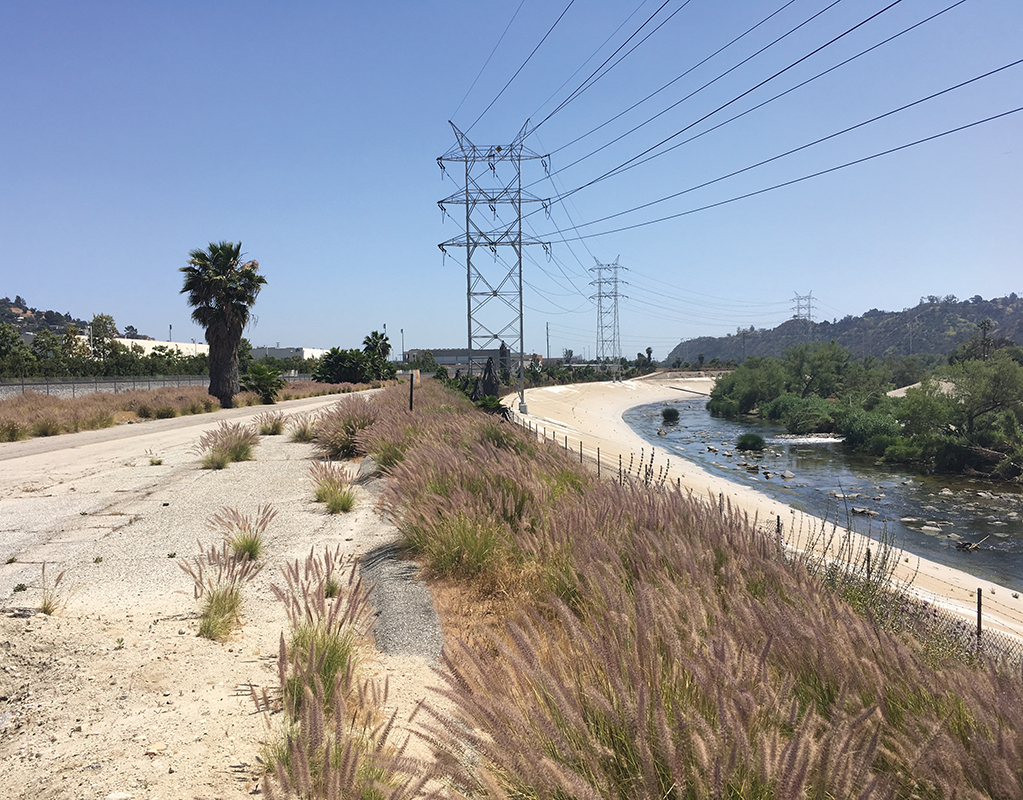
Bowtie Project, Los Angeles, April 2017. Photo: Gwyneth Shanks.
As building draws my analysis through the politics surrounding the revitalization of the L. A. River and a deeper history of water rights in Los Angeles, it frames a constellation among the materiality of the felt world, affect theory, and urban planning. Such a constellation asks us to surface the affective pleasures and traumas of urban sites and as well as the ways affect is produced through the built dimensions of public space. Brown affect, Muñoz writes, is “the sharing out of a brown sense of the world…that…maintains the urgencies and intensities we experience as freedom and difference.”9 Dust and dirt, I argue in this essay, are such material means of sharing out a brown sense of the world.
Some fifty miles long, the L.A. River begins in Simi Hills and the Santa Susana Mountains. It winds its way east through the San Fernando Valley, before curving south and cutting through Atwater Village, Echo Park, Boyle Heights, Vernon, East Compton, and then washing out into the Pacific Ocean in Long Beach Harbor. The L. A. River, which yearly overflowed its banks, was transformed into a concrete system of flood control channels following the 1938 flood, which claimed an estimated 144 lives.10 The large-scale engineering project, undertaken by the Army Corps of Engineers and funded through the Works Progress Administration, also opened up swaths of land previously too dangerous to build on, due to the threat of flooding. Long before it became a concrete river, the Tongva and Chumash tribes occupied the flood basin. Later, the abundance of fresh water made the area ideal for Spanish colonizers. It was briefly the capital of Alta California under Mexican rule and, eventually, the final respite for later waves of American settler colonialists moving westward. Today, it offers little water to the city or county. Instead, Los Angeles imports most of its water from other parts of the state via aqueducts.
Parker’s The Unfinished, Esparza and Hernandez’s “stage,” is 137 feet long and was achieved by digging down through the road’s asphalt surface. The Unfinished is a full-scale replica of an Egyptian archaeological site known as The Unfinished Obelisk, which was abandoned after a fissure was discovered running through the granite. The title of Esparza and Hernandez’s performance—building: a simulacrum of power—draws inspiration from Parker’s work. An obelisk, their title indicates, is merely a simulacrum of power. This naming of the representation of power challenges the pharaonic authority of the original obelisk to which Parker’s earthwork alludes. It also, if obliquely, references the Bowtie’s history of industrial use. It took six months for Parker to get clearance from the parks department to drill down into the asphalt surface of the roadway, due to concern about lingering soil toxicity resulting from the site’s former use as a rail yard and switching station.
For their performance, Esparza and Hernandez covered the asphalt surface of Parker’s piece with a layer of adobe pavers made from a mixture of dirt, straw, L.A. River water, and horse dung (necessary for ensuring the mixture adhered). Since 2012, Esparza has incorporated adobe bricks or pavers into his performance and sculptural works. With the help of his family, he made by hand the 1,500 pavers that cover the obelisk’s surface, and the material has special significance for him. Prior to immigrating to Los Angeles from Durango, Mexico, as a young man, Esparza’s father Ramon constructed his first home from handmade adobe.11 As Esparza describes it, his own use of bricks is a way of honoring his father’s specific history.
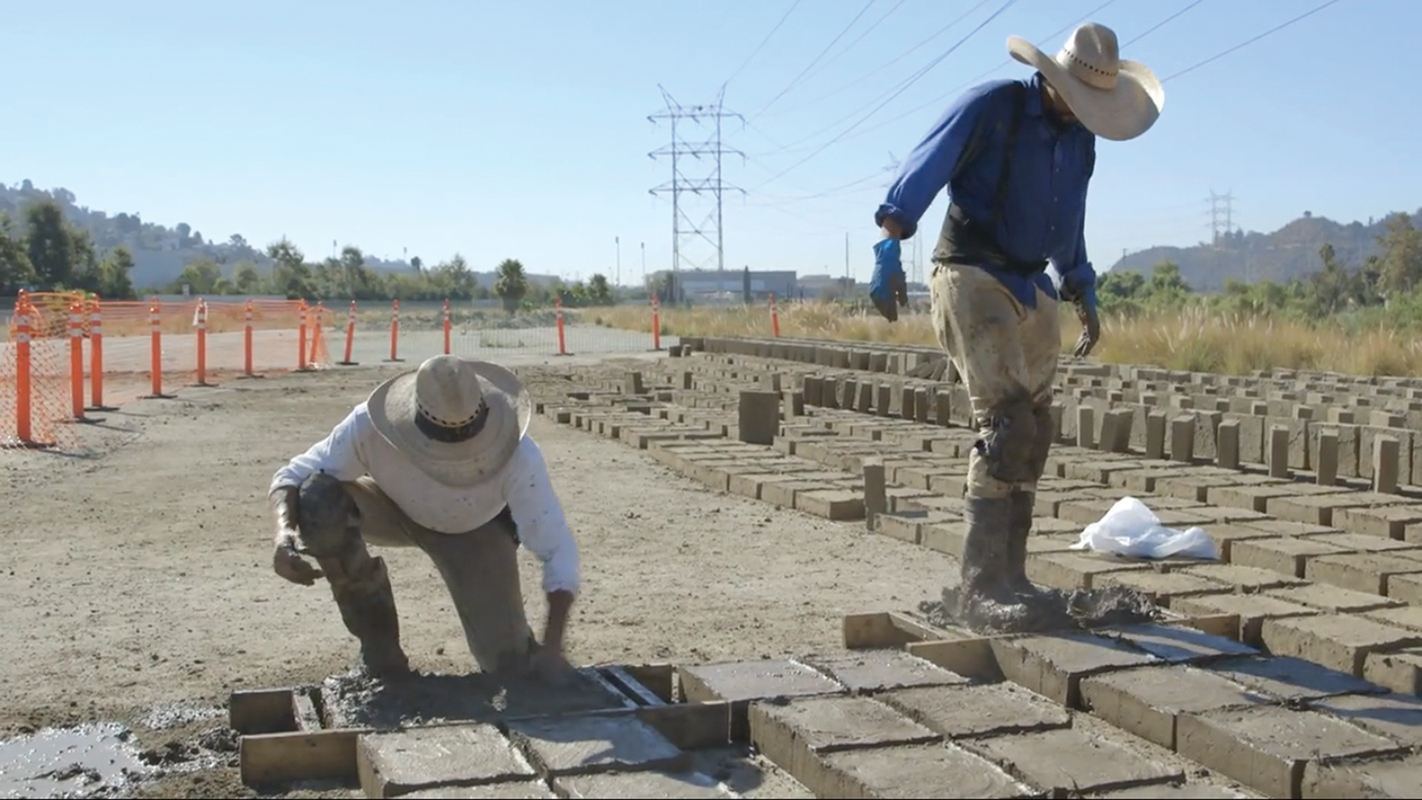
Rafa Esparza and his father, Ramon Esparza, make adobe pavers for building: a simulacrum of power. Video still. Courtesy of Clockshop.
Esparza describes his practice of using adobe as a means of “transform[ing]…[the] environment both artistically and politically,” be it a traditional white cube gallery or the cracked asphalt of a former rail yard.12 As Julia Pelta Feldman writes in her entry on Esparza in the 2017 Whitney Biennial exhibition catalog, his practice materializes a phrase often attributed to Emiliano Zapata: “la tierra es de quien la trabaja con sus manos.” (The land belongs to those who work it with their hands.)13 The adobe in building was a kind of conjuring ground, making possible the felt experience of a different place (and time). To lay one’s bare hands or feet or, indeed, largely naked body, as Esparza did during the performance, on the adobe was to feel a textural world different from that of the asphalt. It is a feeling brown made possible through the felt textures of the adobe. To understand the pavers in this way is to foreground their ability to perform meaning beyond their materiality, precisely because of their earthen composition. Across his various performance and installation works, Esparza describes staging situations in which he can “attempt to experience a time and space inaccessible to” him and, thus, linger in a “different now, a different future.”14 The adobe pavers and bricks, now such an important element to his practice, offer a way of materially transforming the space in which they are installed.
For example, the artist’s 2016 installation, tierra, at the Hammer Museum, was composed of a layer of adobe pavers placed on top of the museum’s white marble floor. Visitors were invited to walk on the pavers, experiencing the embodied sensation of making their way across the uneven bricks. By covering over the museum’s white marble with the hand-hewn pavers, tierra proposed, I argue, a counter future for the museum. It was a future in which the marble, so evocative of the histories of authority, privilege, masculinity, and whiteness that ground Western museums, was obscured by the adobe bricks. The work imagined a future in which such histories are buried beneath layers of mud and dirt. Tierra’s expanse of adobe bricks created a new ground from which to imagine a museum predicated upon alternative aesthetic practices, cultural histories, and models of acquisition and display. Such a future might honor art of the global south, minoritarian artists and museumgoers, and challenge museums’ practice of claiming ownership over objects, artists, and art movements through conventional acquisition and archival procedures. Esparza’s adobe pavers frame a materialized desire for a future different from the now, marking a mode of transformation in which that future is made actual, if only for the duration of a performance.
The Unfinished used archaeological excavation as a conceptual tool for revealing how power, in the abstract, accrues like so many layers of sediment, the form of it only becoming visible by digging down into the dirt. Dirt then—across Parker’s trenches, the toxic soil, and Esparza’s pavers—bears witness to its own history of occupation and degradation. By covering over the cracked asphalt surface of The Unfinished, Esparza offered a different ground from which to move, proposing a counter future for the Bowtie, the nearby river, and the city. It was a future in which the asphalt—which gestures toward Los Angeles’s history of colonization and industrialization—was obscured by mud, and shit, and water.
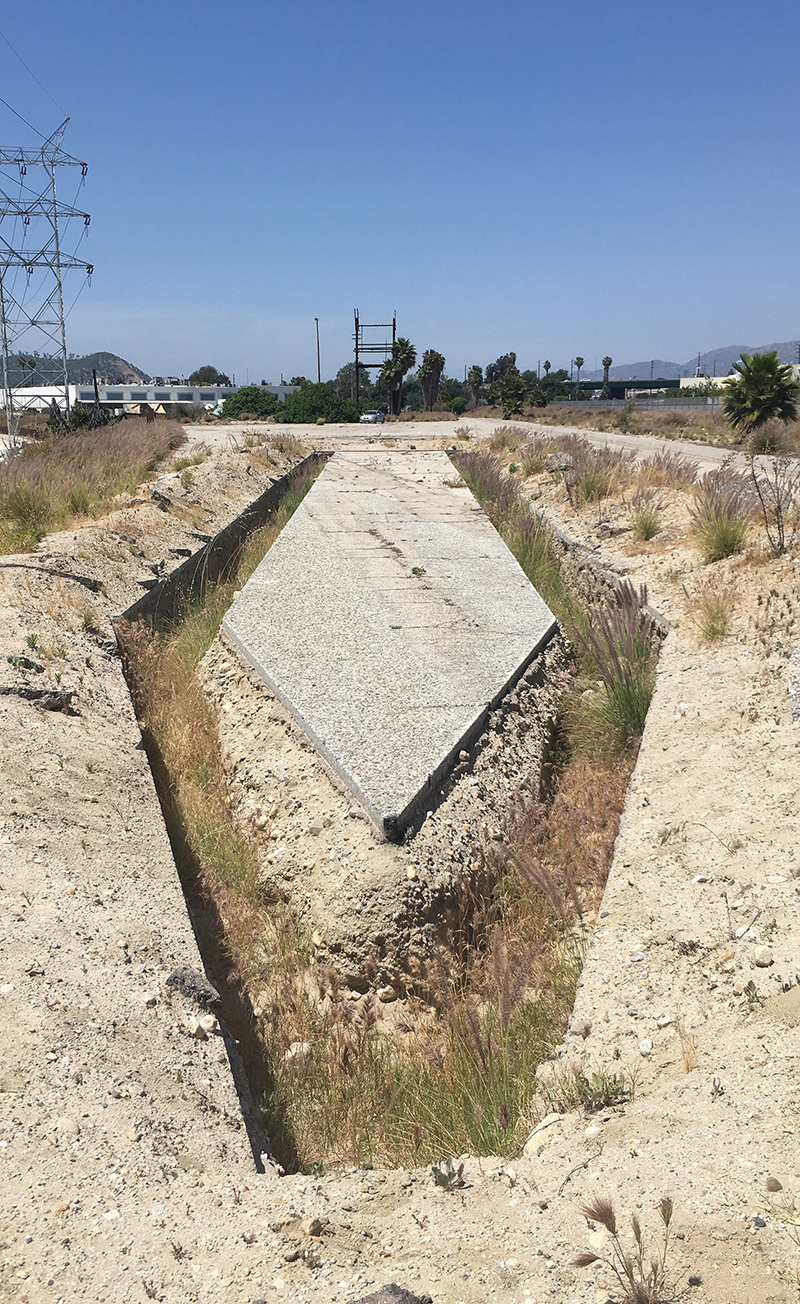
Michael Parker, The Unfinished, 2014. Installation view, Bowtie Project, Los Angeles, April 2017. Photo: Gwyneth Shanks.
Throughout the opening section of building, Hernandez and the three additional dancers stirred up clouds of dust. The majority of their movements were performed in the excavated trench that encircled the obelisk. Only once during their performance did one of the dancers, Stern, stand and move atop the adobe pavers. Making her way down the length of the pavers, Stern sliced her arms back and forth, seeming to trace the geometric contours of the rectilinear obelisk. Mostly, though, the four stayed in the trench, kicking up plumes of dust clouds with their feet and sliding down the steep embankment. Hernandez characterizes their movements as attempts at envelopment.15 While this term was meant to describe the phenomenological sensation of sliding across the dirt embankment, the plumes of dust generated from the dancers’ movements ensured that all who viewed the piece were likewise enveloped in a fine layer of brown.
The relationship between dust and absent water in California extends well beyond the environmental conditions of Bowtie in the summer of 2014 and the state’s recent five-year drought.16 Owens Lake, in Owens Valley, was largely drained in 1913 to feed the first of Los Angeles’s two aqueducts. The land was acquired in the early twentieth century through a series of subterfuges, in which Los Angeles Department of Water and Power (LADWP) agents posed as ranchers and farmers to buy land and water rights. A little over ten years later, the valley was desiccated. The LADWP, together with the California State Lands Commission, still owns the vast majority of the largely dry Owens Lake bed, which is now a large salt flat. Periodic winds whip across the area and stir up huge alkali dust storms that rain some four million tons of dust on the surrounding areas. Settlements reached a little over ten years ago between LADWP and the Mono Lake Committee returned some water to the valley and required the department to instigate a series of land management measures aimed at mitigating the dust storms. Nevertheless, Owens Lake bed remains the single largest source of dust pollution in the United States. While dust is an ongoing environmental and health concern in California, the fine particulate matter is also metonymic, gesturing toward neo-colonial practices of dispossession, disenfranchisement, and environmental devastation.
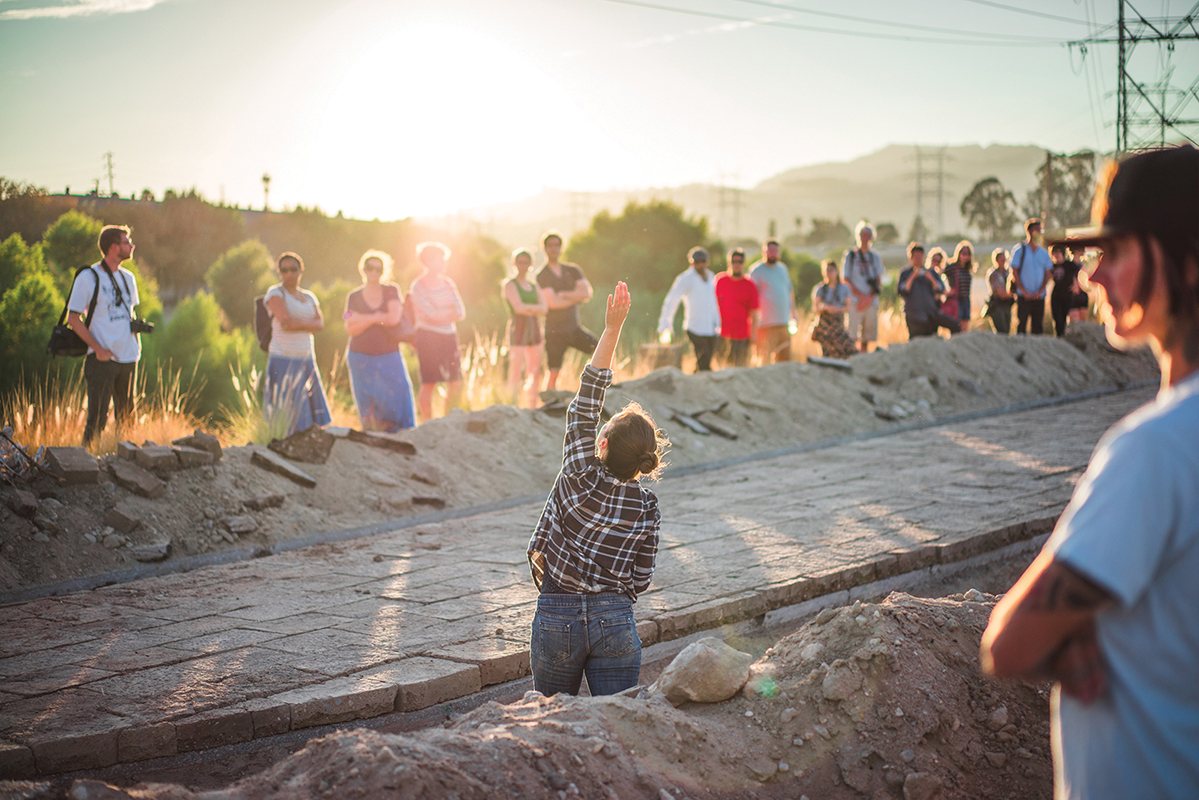
Rafa Esparza and Rebeca Hernandez, building: a simulacrum of power, 2014. Performance on the site of Michael Parker’s The Unfinished (2014) at the Bowtie Project, August 24, 2014. Courtesy of Clockshop. Photo: Dylan Schwartz.
Within the context of California and water rights, dust carries specific historical and environmental meanings. Dust and dirt also connote a more broadly defined set of assumptions about poverty, disease, deprivation, lowliness, and mortality. Meanwhile, its absence connotes not only cleanliness but also morality. The dust Hernandez and her dancers generated not only evoked the fraught history of water rights in California but also challenged Euro-American—and by extension white—perceptions of morality, which cling so perniciously to notions of cleanliness. The dust in building thus formed a signifying matrix in which the plumes of grit surfaced narratives of neo-colonial territorial dispossession at the same time as they countered the affective and cultural privilege that attaches to the material and imagined absence of dirt and dust.
Following the conclusion of the four women’s dance, Esparza began his solo, and Hernandez took her place at the tip of the obelisk, with the mirror held in her arms for the duration of his performance. The majority of Esparza’s performance was taken up by his slow crawl down the length of the obelisk. As he inched forward, he loosened the ties securing the loincloth wound round his waist; he arrived at the point of the obelisk clothed in only a jock strap. Once there, he penetrated himself anally with the sharp tip of the small triangular adobe brick positioned at the tip of Parker’s obelisk, in a gesture evocative of Los Angeles performance artist Ron Athey.17 Afterward, Esparza dressed in slacks, a button-up shirt, tie, and blazer and poured a small bucket of water over his head, drenching his face and chest in the cooling liquid. Finally, he removed the adobe triangle and replaced it with an offering of white sage. The piece ended as he burned the sage plant, in a ritual of smudging, or readying, the space for ceremony. Coming at the end of his and Hernandez’s performance, the gesture seemed to connote a different notion of ceremonial time, leaving the obelisk and the Bowtie open to receive embodied acts distinctly different from those of the rail yard or investment-driven revitalization of the river.

Rafa Esparza and Rebeca Hernandez, building: a simulacrum of power, 2014. Rafa Esparza performs on the site of Michael Parker’s The Unfinished (2014) at the Bowtie Project, Los Angeles, August 24, 2014. Courtesy of Alexis Chanes. Photo: Alexis Chanes.
However inadvertently or obliquely, organizations like Clockshop, Play the LA River, and Current: LA play a vital role in the success of large-scale redevelopment plans for the L.A. River and its surrounding neighborhoods. 18 Current: LA, for example, was largely sponsored by Bloomberg Philanthropies, the philanthropic arm of Michael Bloomberg’s company, Bloomberg LP. The company opened offices in Los Angeles in 2015, and is financially backing real estate projects along the L.A. River that aim to transform such riverfront properties into high-end condos and mixed-use developments. While such projects draw attention to the river’s environmental devastation through curating progressive art, they nevertheless depend upon the gentrifying logic of cultural capital. In other words, the more appealing the Bowtie becomes through increased parks department attention or ever more art installations, the more property and rent prices in the surrounding neighborhoods go up. Such shifts are already transforming Frogtown, the area around the Bowtie. Largely Latino and working-class, the neighborhood has attracted development over the past six years, as new residents move in and post-industrial properties are purchased and earmarked for redevelopment. (In 2014 alone, five riverfront properties were purchased.19) An 80-page report published by LA-Más, a non-profit organization that helps underserved communities shape the futures of their neighborhoods through policy creation and architectural projects, revealed longtime Frogtown residents’ concerns about their neighborhood’s shifting landscape and affordability. In light of the rapidly changing constitution of certain neighborhoods, Esparza’s concluding gesture can be viewed as one that surfaced epistemologies of land and water use of formally colonized or dispossessed communities. His final ritual practices formed a relationship of sorts between his imagined communities and the current long-term residents of areas like Frogtown. Esparza transformed conventional narratives around urban revitalization to privilege a brown-becoming.
Building offered a performative means of lingering over and remembering the nearby, yet nearly empty, L. A. River. It also asked viewers to imagine how the river and its surrounding earth remember us. Such a framing is not simply a metaphoric personification of the river but rather is an assertion of the vitalness of the material and elemental world. It is a means of, as performance scholar May Joseph writes, articulating water as “a substance whose political agency participates in the public sphere, shaping the everyday lives and the futures of humans and nonhumans alike.”20 To imagine, across these distinct registers of water epistemologies, the river as vital and embodied illuminates a different notion of temporality. The river, if now largely contained and managed by flood channels and concrete, nevertheless draws us backwards in geological time and to different eras of human occupation. The river as flowing political agent articulates not the passing away of these periods of occupation but rather their contemporaneousness with our present. Building performs a sharing outwards of this sense of the river and the land surrounding it that, to return to Muñoz, “maintains the urgencies and intensities we experience as freedom.”21
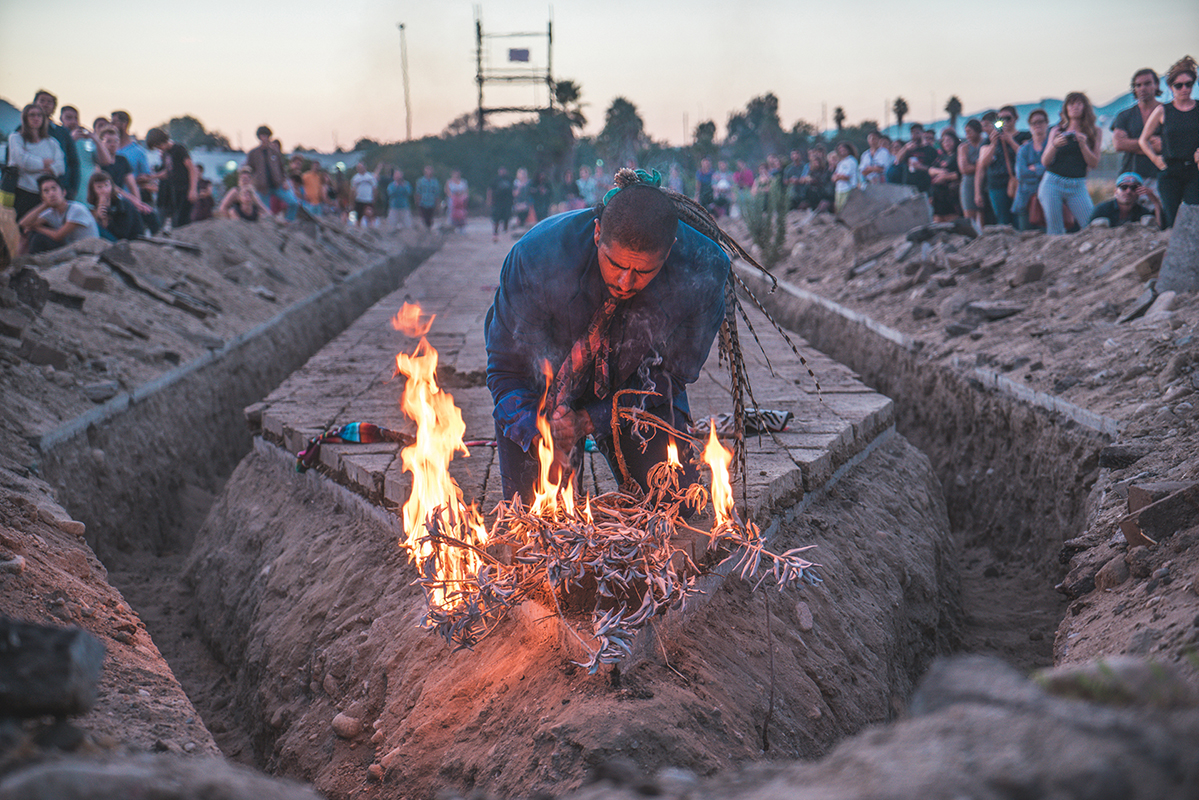
Rafa Esparza and Rebeca Hernandez, building: a simulacrum of power, 2014. Rafa Esparza performs on the site of Michael Parker’s The Unfinished (2014) at the Bowtie Project, Los Angeles, August 24, 2014. Courtesy of Clockshop. Photo: Dylan Schwartz.
Water is life. And in its absence, only dust and dirt and cracked asphalt remain. In writing about what brown-becoming might mean in and through Ana Mendieta’s work and biography, Muñoz located vitalness as key to its enunciation. Brownness, he wrote, produces a “vital materialist afterburn.” 22 This notion draws together French philosopher Henri Bergson’s vital force—which sought to link all of life together through a “single invisible embrace,” or creative principle—with the historical precarity of dispossessed peoples. This turn in Muñoz’s work offers a way to draw the phrase “water is life” into critical theory, imagining the truism as at once an epistemology, an activist rallying cry, and a means of articulating a brown sense of the world. Such a sense acknowledges the phrase’s epistemological specificity, which challenges corporate and municipal interests at the same time that it grapples with the historical and ongoing conditions of precarity that produce modes of brown feeling. “Water is life” articulates the affective tension between a material present and an aesthetic and, perhaps more utopic, symbolic order. If fights concerning access to and sovereignty over water, like those animating the construction of underground crude oil pipelines, like Dakota Access Pipeline and Pipeline 3, have often privileged corporate interests, municipal water departments, and affluent communities, then Esparza and Hernandez’s building frames a way of expanding what might be meant by water’s symbolic order and offers a way into the brownness of dust and dirt and adobe.
Gwyneth Shanks is a Mellon Postdoctoral Fellow at the Walker Art Center. She earned a PhD in Theater and Performance Studies from UCLA, and her work has appeared in, amongst other places, Third Text, Performance Matters, and the Journal of Dramatic Theory and Criticism.
